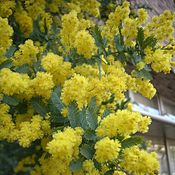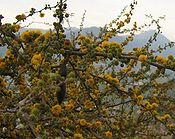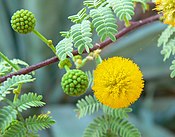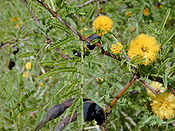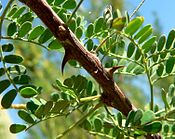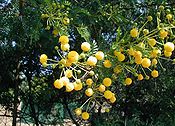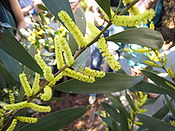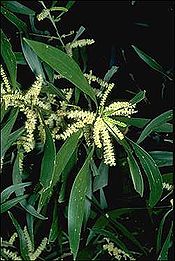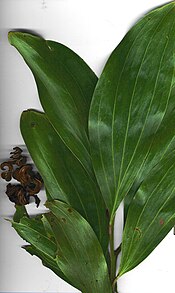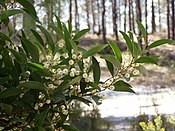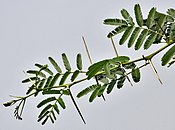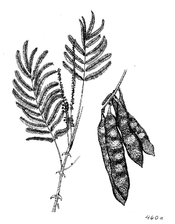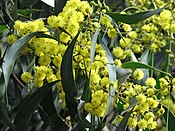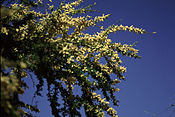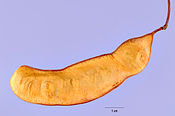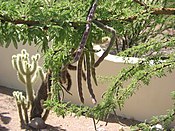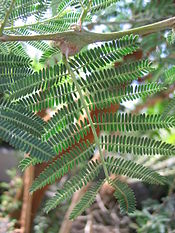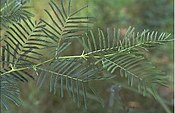don't know personally what it does for you.
Phytochemistry of Acacia
[edit] Alkaloids
Egyptian goddess Isis
As mentioned previously, Acacias contain a number of
organic compounds that defend them from pests and grazing animals.
[4] Many of these compounds are
psychoactive in humans. The
alkaloids found in Acacias include
dimethyltryptamine (DMT),
5-methoxy-dimethyltryptamine (5-MeO-DMT) and
N-methyltryptamine (NMT). The plant leaves, stems and/or roots are sometimes made into a brew together with some
MAOI-containing plant and consumed orally for healing, ceremonial or religious uses.
Egyptian mythology has associated the acacia tree with characteristics of the
tree of life (see the article on the
Myth of Osiris and Isis).
Acacias Known to Contain Psychoactive Alkaloids
Acacia acuminata Up to 1.5% alkaloids, mainly consisting of
tryptamine in leaf
[19] Acacia adunca β-methyl-phenethylamine, 2.4% in leaves
[20]
Acacia alpina Active principles in leaf
[21]
Acacia aneura Ash used in
Pituri.
[22] Ether extracts about 2-6% of the dried leaf mass.
[23] Not known if psychoactive
per se.
Acacia angustissima β-methyl-phenethylamine
[24], NMT and DMT in leaf (1.1-10.2 ppm)
[25]
Acacia aroma Tryptamine alkaloids.
[26] Significant amount of tryptamine in the seeds.
[27]
Acacia auriculiformis 5-MeO-DMT in stem bark
[28]
Acacia baileyana 0.02% tryptamine and
β-carbolines, in the leaf,
Tetrahydroharman[21][29][30] Acacia beauverdiana Psychoactive
[31] Ash used in
Pituri.
[22]
Acacia berlandieri DMT,
amphetamines,
mescaline,
nicotine[32]
Acacia catechu DMT
[33] and other tryptamines in leaf, bark
Acacia caven Tryptamines
Acacia chundra DMT and other tryptamines in leaf, bark
Acacia colei DMT
[34] Acacia complanata 0.3% alkaloids in leaf and stem, almost all N-methyl-tetrahydroharman, with traces of
tetrahydroharman, some of tryptamine
[35][36][37]
Acacia concinna Nicotine
[38]
Acacia confusa DMT & NMT in leaf, stem & bark 0.04% NMT and 0.02% DMT in stem.
[21] Also N,N-dimethyltryptamine
N-oxide[39]
Acacia constricta β-methyl-phenethylamine
[24] Acacia coriacea Ash used in
Pituri.
[22][40] Not known if psychoactive.
Acacia cornigera Psychoactive,
[40] Tryptamines
[11]
Acacia cultriformis Tryptamine, in the leaf, stem
[21] and seeds.
[27] Phenethylamine in leaf and seeds
[27] Acacia cuthbertsonii Psychoactive
[31] Acacia delibrata Psychoactive
[31] Acacia falcata Psychoactive,
[31] but less than 0.02% alkaloids
[30]
Acacia farnesiana Traces of 5-MeO-DMT
[41] in fruit. β-methyl-phenethylamine, flower.
[42] Ether extracts about 2-6% of the dried leaf mass.
[23] Alkaloids are present in the bark
[43] and leaves.
[44] Amphetamines and mescaline also found in tree.
[11] Acacia filiciana Added to Pulque, but not known if psychoactive
[40] Acacia floribunda Tryptamine, phenethylamine,
[45] in flowers
[27] other tryptamines,
[46] phenethylamines
[47]
Acacia greggii N-methyl-β-phenethylamine,
[24] phenethylamine[4] Acacia harpophylla Phenethylamine,
hordenine at a ratio of 2:3 in dried leaves, 0.6% total
[20] Acacia holoserica Hordenine, 1.2% in bark
[20]
Acacia horrida Psychoactive
[40]
Acacia implexa Psychoactive
[48] Acacia jurema DMT, NMT
Acacia karroo Psychoactive
Acacia kempeana Used in Pituri, but not known if psychoactive.
[40] Acacia kettlewelliae 1.5
[20]-1.88%
[49] alkaloids, 92% consisting of
phenylethylamine.
[20] 0.9% N-methyl-2- phenylethylamine found a different time.
[20]
Acacia laeta DMT, in the leaf
[21] Acacia lingulata Used in Pituri, but not known if psychoactive.
[40]
Acacia longifolia 0.2% tryptamine in bark, leaves, some in flowers, phenylethylamine in flowers,
[45] 0.2% DMT in plant.
[50] Histamine alkaloids.
[30] Acacia longifolia var.
sophorae Tryptamine in leaves, bark
[27] Acacia macradenia Tryptamine
[27]
Acacia maidenii 0.6% NMT and DMT in about a 2:3 ratio in the stem bark, both present in leaves
[21]
Acacia mangium Psychoactive
[40]
Acacia melanoxylon DMT, in the bark and leaf,
[51] but less than 0.02% total alkaloids
[30]
Acacia mellifera DMT, in the leaf
[21]
Acacia nilotica DMT, in the leaf
[21] Acacia nilotica subsp.
adstringens Psychoactive, DMT in the leaf
Acacia obtusifolia Tryptamine,
[46] DMT, NMT, other tryptamines,
[52] 0.4-0.5% in dried bark, 0.07% in branch tips.
[53] Acacia oerfota Less than 0.1% DMT in leaf,
[29][54] NMT
Acacia penninervis Psychoactive
[31]
Acacia phlebophylla 0.3% DMT in leaf, NMT
[21]
Acacia podalyriaefolia Tryptamine in the leaf,
[21] 0.5% to 2% DMT in fresh bark, phenethylamine, trace amounts
[45]
Acacia polyacantha DMT in leaf
[21] and other tryptamines in leaf, bark
Acacia polyacantha ssp. campylacantha Less than 0.2% DMT in leaf, NMT; DMT and other tryptamines in leaf, bark
[55] Acacia prominens Phenylethylamine, β-methyl-phenethylamine
[20][45] Acacia pruinocarpa Ash used in
Pituri.
[22][40] Not known if psychoactive.
Acacia pycnantha Ash used in Pituri,
[40] but less than 0.02% total alkaloids.
[30] Not known if psychoactive.
Acacia retinodes DMT, NMT,
[56] nicotine,
[11] but less than 0.02% total alkaloids found
[30]
Acacia rigidula DMT, NMT, tryptamine, amphetamines, mescaline, nicotine and others
[57]
Acacia roemeriana β-methyl-phenethylamine
[24]
Acacia salicina Ash used in
Pituri.
[22][40] Not known if psychoactive.
Acacia sassa Psychoactive
[40]
Acacia schaffneri β-methyl-phenethylamine,
Phenethylamine[4] Amphetamines and mescaline also found.
[11] Acacia schottii β-methyl-phenethylamine
[24]
Acacia senegal Less than 0.1% DMT in leaf,
[21] NMT, other tryptamines. DMT in plant,
[42] DMT in bark.
[27]
Acacia seyal DMT, in the leaf.
[21] Ether extracts about 1-7% of the dried leaf mass.
[23]
Acacia sieberiana DMT, in the leaf
[21]
Acacia simplex DMT and NMT, in the leaf, stem and trunk bark, 0.81% DMT in bark, MMT
[21][58] Acacia taxensis β-methyl-phenethylamine
[24]
Acacia tortilis DMT, NMT, and other tryptamines
[52] Acacia vestita Tryptamine, in the leaf and stem,
[21] but less than 0.02% total alkaloids
[30] Acacia victoriae Tryptamines,
[46] 5-MeO-alkyltryptamine
[27]
[edit] List of acacia species having little or no alkaloids in the material sampled:[30]
0%
C
0.02%, C...Concentration of Alkaloids [%]
[edit] Cyanogenic glycosides
Nineteen different species of Acacia in the Americas contain
cyanogenic glycosides, which, if exposed to an
enzyme which specifically splits glycosides, can release
hydrogen cyanide (HCN) in the acacia "leaves."
[59] This sometimes results in the poisoning death of
livestock.
If fresh plant material spontaneously produces 200 ppm or more HCN, then it is potentially toxic. This corresponds to about 7.5 μmol HCN per gram of fresh plant material. It turns out that, if acacia "leaves" lack the specific glycoside-splitting enzyme, then they may be less toxic than otherwise, even those containing significant quantities of cyanic glycosides.
[30]
Some Acacia species containing cyanogens:
- Acacia erioloba
- Acacia cunninghamii
- Acacia obtusifolia
- Acacia sieberiana
- Acacia sieberiana var. woodii[60]
::-i know alot about 'herbs' not necessarily suppplements, but maybe what theyre made of..











